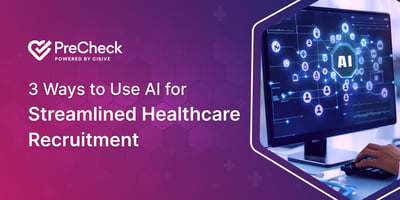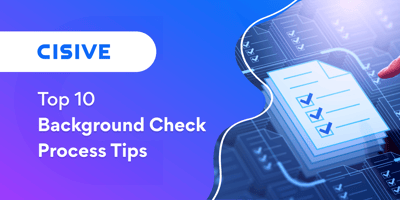

As an HR leader in healthcare, you’re constantly juggling the urgent need to fill critical...

Hiring and retaining talent is critical to the success of any business. But competition for top talent is harder than ever. Recruiters and HR teams must continually overcome roadblocks, from communication gaps to skill mismatches, as they try to attract the best people.
We talk to hiring managers across the country and across industries, including healthcare, financial services, manufacturing, transportation, and staffing. By listening to their struggles, we’ve compiled a list of some of the most common issues that HR managers face. In this article, we’ll highlight five of the biggest challenges, along with highly effective solutions that can help you accomplish your hiring goals.
Key TakeawaysHere’s what you need to know to understand and overcome hiring challenges in 2025:
|
The economy and job market, as well as hiring regulations, are all changing in 2025. The Trump administration has taken swift and drastic action on topics from immigration to tariffs. Companies are operating in an environment of uncertainty.
One effect of this appears to be an overall slowdown in hiring. In fact, aside from the pandemic drop in 2020, hiring rates haven’t been this low since 2013, according to a recent article. Now is the time to realize that there are many qualified candidates actively looking for work. You just need to find them.
It’s time to scrutinize your hiring process. Identify your biggest hiring challenges and weaknesses and address them. If you don’t, you’ll be wasting time and money on outdated practices. Addressing these challenges positions your company to hire the best talent.

Navigating today’s ever-changing business landscape is a struggle. You’re facing evolving candidate expectations, internal pressure to find people quickly, and macroeconomic issues over which you have no control.
As an HR professional, it’s crucial to have an informed strategy for talent acquisition. Developing that strategy means understanding these hiring challenges and finding practical solutions to overcome them.
Filling your talent pipeline with skilled candidates isn’t easy. Traditional job postings aren’t enough to attract the right people — especially when some job sites are filled with fake listings and scams. It’s especially difficult in competitive industries like finance, IT, healthcare, and transportation.
The last thing you can afford to do is make a bad hire. To avoid that, your HR staff must know how to spot various candidate red flags. You don’t just want to hire someone; you want to hire the right someone.
Job seekers evaluate companies just like companies evaluate job seekers. Increase your chances of finding the right person with these tasks:
As we said earlier, the pace of hiring is the slowest it’s been in over a decade. Many people are applying for jobs. Plus, reductions in the federal workforce are increasing the applicant pool. Depending on the type of job you’re hiring for, you might find yourself flooded with applications within the first day or two.
The more applications you have, the more work it is to sift through them. This can slow down your process to the point where candidates may begin interviewing for other positions before you even respond to their submission. Quickly handling applications keeps those candidates in your pool, not your competitor’s.
So, how can you and your HR staff deal with an influx of resumes without getting bogged down? Here are a few options.
You’re fishing for candidates in the same pond as a lot of other companies and recruiters. Sometimes, the competing organizations will have more resources than you or a more well-known brand. It may feel like all your best candidates end up working for other companies.
But remember that you are competitive too. You just need a way to show it to the candidates.
Position your company to compete by:
You and your staff cannot work 24 hours a day. You have responsibilities besides focusing on hiring a single role. Being stretched too thin is one of the most common problems in all of HR.
If you’re overwhelmed, the hiring process will suffer, and you’ll lose quality candidates to competitors who are more responsive. To be successful, you need to make your hiring process as efficient as possible.
First, assess your current situation and identify your biggest roadblocks. Think about where these tips can help you most.
A long, complicated hiring process leads to frustrated candidates who then remove themselves from consideration. It also causes you to lose candidates to other companies that move faster than you.
Whether the delay is caused by a single bottleneck or an overall slow and manual process, you need to address it. Leaving it as-is will only make you lose more good candidates over time, leaving you with a substandard workforce.
2025 has brought big changes in the employment world. Whether it’s changes in policies driven by the new administration or state-level changes to employment laws, compliance is a big topic. Here are just a few compliance-related items to be aware of:
It’s essential that you have a compliance-first screening solution. It should spot red flags and keep you in line with the laws and regulations of every hiring location. Cisive’s solution offers exactly that. And, we educate you on compliance-related topics with in-depth thought leadership resources.
Organizations across industries rely on Cisive background screening solutions to expedite the hiring process. We offer a single platform for background checks, drug screenings, I-9 compliance, post-hire monitoring, and business intelligence.
Our clients are often from highly regulated industries, including financial services, healthcare, transportation, and technology. We have deep knowledge of the regulatory and legal issues facing these organizations. Clients rely on our solutions when hiring for everything from entry-level roles to executive positions.
As your hiring teams face more challenges, Cisive can help integrate your talent acquisition processes. Above all, we are dedicated to providing the best customer support in the industry.
The hiring landscape has shifted in 2025. Don’t get left behind using outdated recruitment processes.
Speak with a Cisive expert about how to solve background screening and hiring challenges for today’s world. Whether you’re trying to shorten your hiring process or discover candidate red flags to hire the right person, Cisive has your solutions.

As an HR leader in healthcare, you’re constantly juggling the urgent need to fill critical...

Employees are the heart of your company. Their salaries and benefits are also most companies’...

Enterprise organizations are often required to respond to changes in workforce and business...